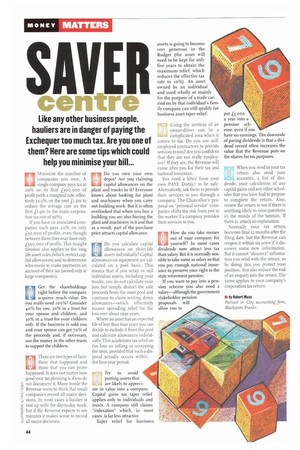Like any other business people, hauliers are in danger of
Page 46

If you've noticed an error in this article please click here to report it so we can fix it.
paying the Exchequer too much tax. Are you one of them? Here are some tips which could help you minimise your
12 Minimise me numoer of companies you own. A single company pays tax at zo% on its first 1300,000 of profit (with a marginal rate, effectively 32.5%, on the next f1.2m to reduce the average rate on the first ii.5m to the main corporation tax rate of 30%).
If you have to associated cornpanies each pays 20% on only 130,000 of profits, even though between them they may have only I300,000 of profits. This straight division also applies to the long life asset rules (which restrict capital allowances) and to determine who needs to make payments on account of their tax (aimed only at large companies).
riGet the shareholdings right before the company acquires much value. Do you really need t00%? Consider 40% for you, 30% in a trust for your spouse and children, and 3o% in a trust for your children only. If the business is sold you and your spouse can get 70% of the proceeds and, if necessary, use the money in the other trusts to support the children.
C There are two types of facts:
those that happened and those that you can prove happened. It does not matter how good your tax planning is if you do not document it. Many inside the Revenue seem to think that small companies record all major decisions. In most cases a haulier is tied up with the day-to-day work, but if the Revenue expects to see minutes it makes sense to record all major decisions.
uDo y ou own your own I depot? Are you claiming capital allowances on the plant and trucks in it? Everyone knows about looking for plant and machinery when you carry out building work. But it is often overlooked that when you buy a building you are also buying the plant and machinery in it and that as a result, part of the purchase price attracts capital allowance.
ElDo you calculate capital allowances on short-life assets individually? Capital allowances on equipment are calculated on a pool basis. This means that if you scrap or sell individual assets, including your trucks, you do not calculate your loss but simply deduct the sale proceeds from the asset pool and continue to claim writing down allowances—witich effectively means spreading relief for the loss over about nine years.
Where an asset has an expected life of less than four years you can decide to exclude it from the pool and calculate allowances individually. This accelerates tax relief on the loss on selling or scrapping the item, provided that such a disposal actually occurs within the four-year period.
Try to avoid putting assets that are likely to appreciate in value into a company. Capital gains tax taper relief applies only to individuals and trusts. A company still claims -indexation" which, in most cases, is far less attractive.
Taper relief for business
assets is going to become very generous in the Budget the asset will need to be kept for only five years to obtain the maximum relief, which reduces the effective tax rate to to%). An asset owned by an individual and used wholly or mainly for the purpose of a trade carried on by that individual's family company can still qualify for business asset taper relief.
7 571 Using the services of an owner-driver can be a kLI complicated area when it comes to tax. Do you use selfemployed contractors to provide services to you? Are you confident that they are not really employees? If they are, the Revenue will come after you for their tax and national insurance.
You need a letter from your own PAYE District to be safe. Alternatively, ask them to provide their services to you through a company. The Chancellor's proposal on "personal service" companies shifts the risk from you to the worker if a company provides their services to you.
How do you take money out of your company for yourself? In most cases dividends now attract less tax than salary. But it is normally sensible to take some as salary so that you pay enough national insurance to preserve your right to the state retirement pension.
If you want to pay into a pension scheme you also need a salary—although the government stakeholder pension proposals will allow you to put £3,000 a year into a pension scheme, even if you have no earnings. The downside of paying dividends is that a dividend record often increases the value that the Revenue puts on the shares for tax purposes.
• ,• When you send in your tax return also send your • accounts, a list of dividends, your calculation of any capital gains and any other schedules that you have had to prepare to complete the return. Also, review the return to see if there is anything likely to raise questions in the minds of the taxman. If there is, attach an explanation.
Normally your tax return becomes final 12 months after the filing date, but the Revenue can reopen it within six years if it discovers some new information. But it cannot "discover" information you send with the return, so by doing this you protect your position. You also reduce the risk of an enquiry into the return. The same applies to your company's corporation tax return.
• by Robert Maas
Partner in City accounting firm, Blackstone Franks.








































































































